Prefecture north
In the "prefecture north" which has struggled with frequent hunger in the harsh climate and nature of the mountainous area, the basics of food are cereal grains. Cultivated land opens in the gentle mountains, and many houses make barges and keep a horse, and use the water spring in early spring to turn mills to refine cereals, produce daikon radish, potatoes, pumpkins, etc. that supplement the staple food. It was done.
Housekeeping wisdom is piled up in every one of a variety of preservation, storage and processing devices for a long winter, and rich food that takes advantage of the climate.
[Example] Hand-made soba (Ninohe City)
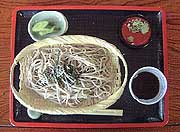
In this region where rice has low elevation, buckwheat has been devised as a daily meal instead of rice. Above all, home-made soba is indispensable for ceremonial occasions.
Central prefecture
The central part of the prefecture, centered on the Kitakami River basin from Morioka to Kitakami, is from the foot of Iwateyama in the north to the north near Kitakami in the south.
Paddy fields have been opened since ancient times, and their scale is relatively large in the prefecture, and production is stable. Barley and wheat are also grown with less snow, and a wide variety of eating habits based on rice and wheat enriches the entire diet.
The rice and wheat flour and soba flour meal "Shito Nemono" are characteristic of this area.
【Example】 Kiri-Sha (Hanamaki City)
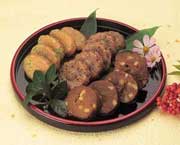
A traditional snack in the rice zone in the central part of the prefecture. It has a sugary taste and a good flavor of the ingredients, and is a shiny and crispy rice cracker.
Prefecture south
During the Shosei period, the prefecture's southern region is the Sendai Territories, and the difference in its history reflects in the production base and the structure of food.
It is characterized by a large amount of food centered on rice, as the rich rice cropland spreading in the lower reaches of the Kitakami River symbolizes. The prefecture south, which is considered to be the “Mochi culture zone,” produces 20 dishes such as the best in Japan for glutinous food, zundo rice, and fusoshi mochi.
Daily meals are also varied, and ingredients such as barley rice, fried rice, fried rice, bite rice, and triple-grained rice are changed seasonally, and dishes based on the taste of miso using koji are served as food.
[Example] celebration mochi (Ichineki city)
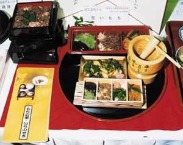
The main ingredients are glutinous rice produced in Ichinoseki and special products (Edamame, Kakii beef, rape blossoms, fresh rice), etc., and it is sold as a convenient “Mochi bento” that adds a new idea to traditional kaki dishes.
Oubayama
A heavy snowfall area surrounded by the deep Ouba mountain range on the border of Akita Prefecture. People in this area where cropland is scattered in the mountains and can not handle wheat because of heavy snow, the main food is fried rice and crab rice, and miso soup often produces natto in mushroom soup.
Spring is wild vegetables such as wild vegetables, autumn is mushrooms, fish of mountain stream, beast of mountain, etc. It is a treasure house of the good luck of the mountain literally, and clever cooking and preservation are featured. Hatahata, salmon and herring, which are sought from the Akita region, are stored under the unique preservation method of sushi pickles and enjoy long winters with pickles that make use of abundant ingredients.
[Example] Natto juice (Nishi Waga-cho)
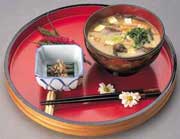
Natto soup is a regional dish that boasts a warm, snowy country.
Besides natto, it is also handed down as sardines, braised pickles, pickles, and tofu.
Sanriku coast
In the sea off Sanriku, where Oshio and Kuroshio collide, fish and shellfish are landed all year round, and abundant seaweed such as kelp and wakame are collected, and dishes with intertwined fish and seaweed create a unique coastal food culture. The
There are few arable lands, and the basic food is bald rice, rice flour, barley, and other three-grained rice, and seaweed-filled mekokome, fifty-noodles (fishing house) dishes using live fish shells and viscera, We eat food in the four seasons.
【Example】 Donko ・ Tara soup (Rikuzentakata City)
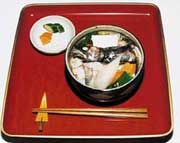
Ezoisoaiameme (called "Donko"), which is often caught on the Sanriku coast, is a fish that is favored as miso soup and hotpot during the winter when the fat content increases.
For the Ebisu class on October 20, we prayed for good fishing with offering a grated donko-ji with an overhead. This practice continues in the Kesen region. In addition, white and light taste is good for postpartum fertilization, and it has been eaten as a dish of strength recovery.
